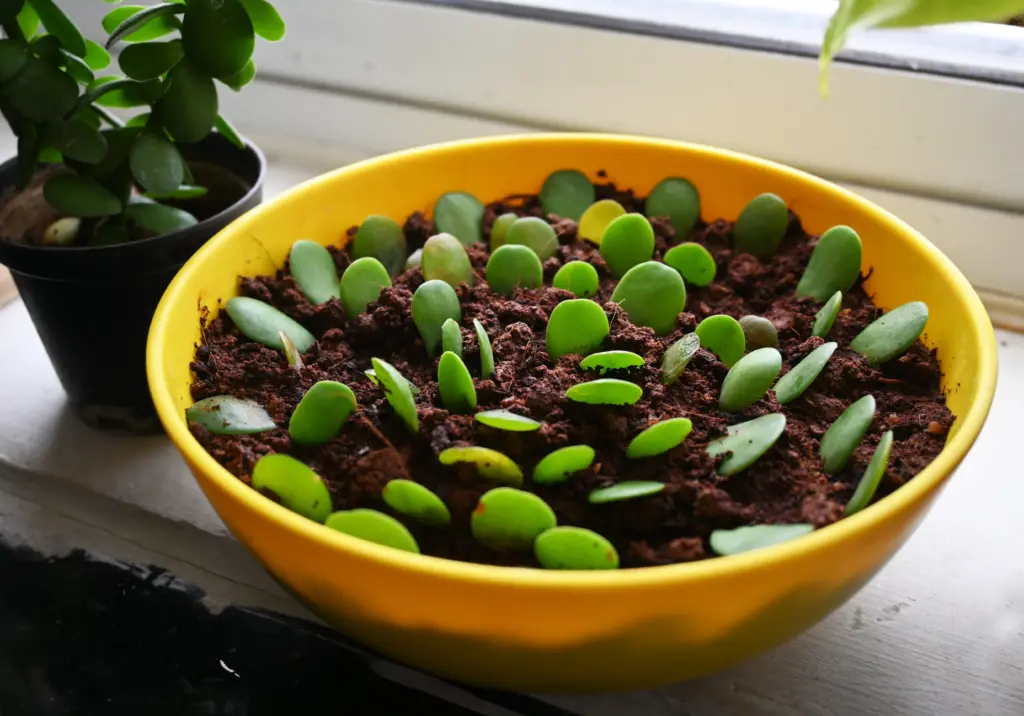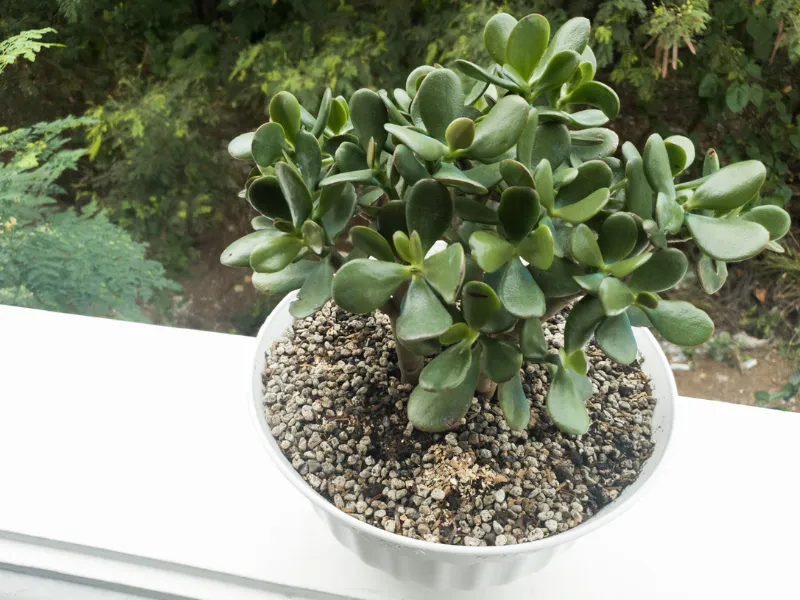If you’re a fan of succulents and looking to expand your collection, propagating a jade plant from leaves is an effective and rewarding method. Jade plants, also known as Crassula ovata, are popular houseplants appreciated for their attractive appearance and easy care. While propagating from cuttings is expected, using leaves to grow new plants can be equally successful and enjoyable. This article will guide you through the step-by-step process of propagating a jade plant from leaves, providing valuable tips and insights to ensure a successful propagation journey. Whether you’re a beginner or a seasoned plant enthusiast, this effective propagation method will soon have you enjoying a flourishing jade plant family.
As a general rule, propagating a jade plant from leaves is a straightforward and gratifying process that allows you to create new plants from existing ones. With their thick, fleshy leaves and resilience, Jade plants lend themselves well to leaf propagation. This method involves carefully selecting healthy leaves, allowing them to callus, and encouraging new roots and stem growth. Whether you wish to expand your jade plant collection, share your favorite plant with friends and family, or enjoy the satisfaction of nurturing new life, learning how to propagate a jade plant from leaves can be a rewarding and enjoyable experience. This guide will take you through the step-by-step process, sharing valuable tips and insights to ensure your success in creating thriving new jade plants.
To successfully propagate the plant in the best way, understand when it is recommended to carry out the propagation process, under what conditions and the exact way to perform the propagation. To know the answers to these questions, keep reading.
When is the best time to propagate jade plants?
The best time to propagate jade plants is during their active growing season, typically in spring and summer. During this time, jade plants are actively producing new growth, and their energy reserves are at their peak, making them more receptive to propagation efforts. Propagating in the spring or early summer allows the newly propagated plants to establish roots and develop robust growth before the onset of colder months or the plant’s dormant period in the fall and winter. However, with proper care and attention, jade plants can be propagated successfully throughout the year. Remember that propagating during the plant’s active growing season provides the best conditions for successful rooting and growth.
How to propagate a jade plant from a single leaf

Propagating a jade plant from leaves is an effective way to create new plants and can be done following these steps:
- Carefully select a mature and healthy jade leaf, ensuring it is free from damage or disease.
- Using a clean knife or scissors, gently remove the leaf from the jade plant, including a small portion of the leaf’s base or stem, known as the leaf node. The leaf node is essential as it contains the potential for new growth.
- Allow the leaf cutting to callus over for a few days in a warm, dry location. This callusing process helps prevent rot when the leaf is planted.
- Once callused, place the jade leaf on top of well-draining soil, ensuring the leaf node is in contact with the soil.
- Water the leaf lightly, providing enough moisture to dampen the soil. Avoid overwatering to prevent root rot.
- Over time, the leaf node will initiate root growth, and tiny new leaves will begin to emerge.
- Be patient and attentive during this process, as it may take some time for the new jade plant to develop fully.
How to propagate a jade plant from stem cuttings
Propagating a jade plant from cuttings is a simple and effective way to create new plants. Follow these steps to propagate your jade plant successfully:
- Carefully select healthy stems from your jade plant for the cuttings. Look for stems at least 3-4 inches long and free from any signs of damage or disease.
- Using a clean knife or scissors, make a clean cut just below a leaf node, which is the point where a leaf is attached to the stem. This will ensure that the cutting has the potential to develop roots and new leaves.
- Once you have your jade plant cuttings, allow the cut ends to callus over in a warm, dry location for a few days. This callusing process helps prevent rot when planting jade cuttings in the soil.
- While the cuttings are callusing, prepare a well-draining potting mix suitable for succulents. A mix of cactus soil and perlite or sand works well for jade plants.
- After the cuttings have callused, gently insert the cut ends into the potting mix, making sure they are inserted about an inch deep into the soil. This will provide stability and encourage root growth.
- Water the cuttings lightly, just enough to moisten the soil. Be careful not to overwater, as jade plants are susceptible to root rot.
- Place the cuttings in a location with bright, indirect light. Avoid placing them in direct sunlight, which can cause the cuttings to scorch.
- The cuttings will develop roots over the next few weeks, and new leaves will emerge from the leaf nodes.
- Be patient and attentive during this process, and soon you’ll have thriving new jade plants propagated from stem cuttings, ready to beautify your indoor or outdoor garden.
How long does it take for jade cuttings to root?
The time it takes for jade cuttings to root can vary depending on various factors such as environmental conditions, temperature, humidity, and the health of the cutting itself. On average, jade cuttings can take a few weeks to a few months to develop roots.
Under optimal conditions, jade cuttings typically show root development within 2 to 6 weeks. During this time, it’s crucial to provide the right amount of water, avoid overwatering to prevent root rot and place the cuttings in a location with bright, indirect light. Additionally, maintaining a warm and stable environment can encourage faster root growth.
However, it’s essential to be patient, as jade plants are slow growers compared to others. Some cuttings may take longer to root, especially if they were taken from mature, woody stems. Don’t be discouraged if you don’t see immediate progress; it’s normal for the rooting process to take some time.
To check for root development, gently tug on the cutting after a few weeks. If you feel resistance or see tiny white root tips when you lift the cutting, it’s a good sign that rooting has begun. Once the cuttings have established strong roots, you can gradually acclimate them to normal watering and care routines, and they will continue to grow into healthy and vibrant jade plants.
How to Care for New Jade Plants

Proper Watering
After successfully propagating your jade plant from leaves using water propagation, caring for your new plants starts with proper watering. Jade plants are succulents adapted to store water in their leaves and stems, so it’s crucial to avoid overwatering. Water the plants sparingly, allowing the soil to dry out slightly between waterings. Use fresh water and ensure good drainage to prevent excess water buildup and the risk of root rot.
Indirect Light
Place your new jade plants in a location with bright, indirect light or indirect sunlight. While jade plants need adequate light to thrive, avoid exposure to direct, intense sunlight, which can lead to leaf scorching. A balance of bright, indirect light throughout the day will promote healthy growth and prevent issues related to light stress.
Suitable Soil Mix
Use a well-draining potting mix specifically formulated for succulent plants, or create your mix with cactus soil and perlite or sand. The right soil mixture ensures good aeration and prevents waterlogged roots, allowing your jade plants to flourish.
Patience with Growth
Jade plants are slow growers, so be patient as your new plants establish strong root systems and grow. Avoid over-fertilizing or over-pruning, as they may stress the young plants. Instead, provide consistent care and attention to help them reach their full potential.
final thoughts
In conclusion, propagating a jade plant from leaves is a fulfilling and effective way to expand your succulent collection. The ability to create a new plant from just a single leaf is undoubtedly one of the easiest ways to propagate jade plants. Jade plants, known as the “lucky plant” or “money tree,” are among the most popular succulents and beloved house plants due to their attractive appearance and low maintenance requirements. By carefully selecting a healthy leaf or jade plant stem from the parent plant, allowing it to callus, and providing the right conditions for growth, you can successfully create new and thriving jade plants. Remember to propagate during the active growing season, provide proper care to ensure the leaf or stem develops into a healthy plant, and exercise patience as the new jade tree grows. Soon, you’ll be rewarded with a flourishing jade plant family, each one a testament to the resilience and beauty of this beloved succulent.
Recent Posts
Unlocking the secret to expanding your begonia maculata family is like discovering a treasure trove of green goodness. If you've ever marveled at the stunning beauty of angel wing begonia leaves and...
If you've ever found yourself marveling at the surreal beauty of air plant blooms, you're in for a treat! These enchanting bursts of color amidst a sea of lush green foliage are like nature's way of...

